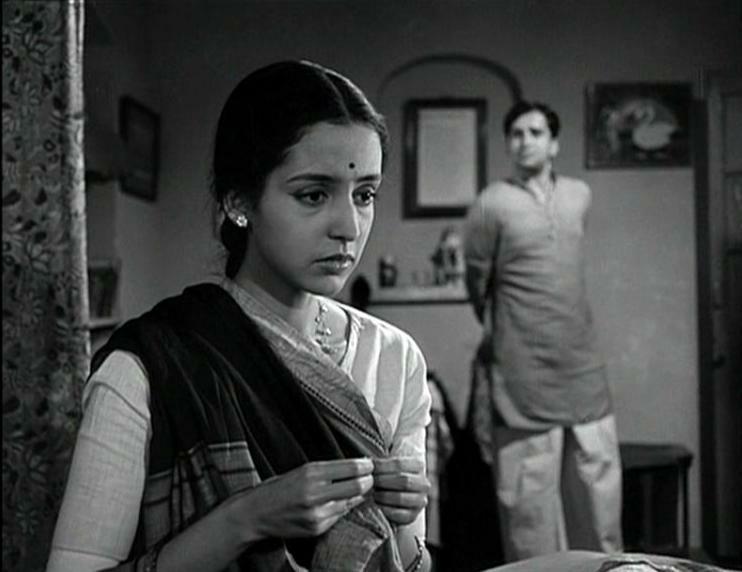Leela Naidu was easily one of the most stunning looking actresses Indian cinema has ever seen and was even named by Vogue magazine as one of the most beautiful women in the world.
Born in 1939 to nuclear physicist Ramaiah Naidu and his French wife, Naidu grew up in Paris and Geneva. She won the Femina Miss India when still in her teens.
Naidu made her debut in Hindi cinema with Hrishikesh Mukherjee’s Anuradha (1960). The film saw her play the title role of a successful singer who marries an idealistic doctor, Balraj Sahni, moves to the village where he works and soon feels bored and stifled in her marriage. Her former lover, Abhi Bhattacharya, has an accident while passing through her village and on meeting her, ignites memories of her past and convinces her that she should return to singing. However, when another doctor recognises her sacrifice as more praiseworthy than that of her husband’s idealism and genius, she recognises his true worth and decides to stay on with him. The film won the President’s Award and is remembered till date for Ravi Shankar’s brilliant music including Jaane Kaise Sapnon Mein Kho Gayi Akhiyan and Kaise Din Beete, both sung by Lata Mangeshkar. Considering it was her first film, Naidu acquitted herself reasonably well even though it has to be said that it is Balraj Sahni’s understated performance that is really the mainstay of the film.
After a gap of almost 3 years, Naidu returned to the silver screen with Yeh Rastey Hain Pyar Ke (1963) and The Householder (1963). The former is an interesting though a much diluted adaptation of the famous ‘Nanavati Murder Case (1959)’, responsible for the abolishment of the jury system in India with Naidu playing the adulterous wife. Though the film borrows elements from the famous case, they are treated in Hindi film fashion. So unlike the real life case, Naidu isn’t really an adulteress (how could she ever be?), of course her drink is spiked for nasty Rehman to score, but she still has to feel defiled and guilty and be the suffering martyr and…surprise surprise – the actual killer is not really Sunil Dutt! Though Naidu looks stunning, her performance, unfortunately, is terribly wooden and stilted showing she still had a long way to go as an actress.
However, she fared much better in the latter, the first ever Merchant-Ivory collaboration. The film, based on a script by Ruth Prawar Jhabvala on her own short story, The Householder, saw Naidu play a woman caught in an arranged marriage, who unable to bear the interference of her mother-in-law in her married life, goes back to her family. It is only in absense that she and her husband, Shashi Kapoor realize that they have fallen in love with each other. Naidu not only looks as beautiful as ever in the film, she gives perhaps her best screen performance ever, even if still a trifle stilted. The film is stunningly photographed on location in Delhi by Subrata Mitra and set the Merchant–Ivory team on their way. Naidu was later to do a cameo in their 1969 film, The Guru.
Naidu’s last stints with mainstream Hindi cinema were Baghi (1964), a costume extravaganza co-starring Pradeep Kumar, Vijaya Choudhury and Mumtaz, and Aabroo (1968), where she played a supporting role of the typical suffering ‘Bharatiya Nari’. She did make another film, Ummeed co-starring Ashok Kumar, Joy Mukerji and Nanda, forming the third part of the love triangle, but the film, started in 1962, was much delayed, never released and has a censor date of 1971. It is said that she was considered for the English version of Guide (1965) but lost out to Waheeda Rehman due to her lack of dancing skills.
On the personal front, Naidu married Tilak Raj ‘Tikki’ Oberoi, the son of Mohan Singh Oberoi, the founder of the Oberoi Chain of Hotels. However, the marriage did not work out and after the divorce, she lost the custody of her twin daughters. She then married poet Dom Moraes. But sadly for her, this marriage too didn’t work out.
Naidu took refuge in philosopher J Krishnamurthi after she lost custody of her daughters. On finding solace in Krishnamurthi, Naidu recalled in an interview, “I was very unhappy. I spoke to him and he heard me out with that vast listening he was capable of. Then, he told me I would have to learn to live with it. It was a remark I would not have accepted from anyone, not even my parents. But I accepted it from him. I remember crying. At another time he remarked that, if all I wanted was to be as sensitive as possible, then I was sitting on a volcano — and I would have to live with grief.”
Naidu made a return to acting years later with Shyam Benegal’s Trikal (1985) and was used most effectively by Benegal as the matriarch of a Goan Christian family coming to terms with the death of her husband even as the Indian Army is set to take over Portuguese administered Goa in 1961. Her last film appearance came seven years later in the Pradip Krishen directed Electric Moon (1992), a dig at wealthy western tourists, who come to India to experience their stereotypical impressions of India. The film showed that few women have aged as graciously as Naidu, who just seemed to have got even more beautiful and dignified as she grew older.
Naidu died of lung failure in Mumbai on July 28, 2009, following a prolonged illness. She was 69.


